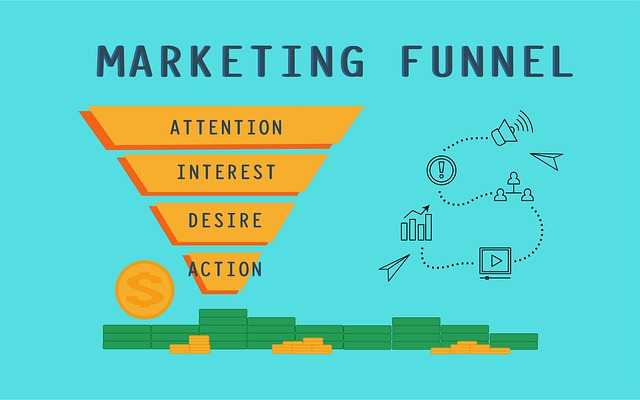How Do You Build A Marketing Funnel?
The human brain craves order and process. It operates in a structured way and understands step-by-step systems. A marketing funnel is just a way to make you think of your marketing in a visual way that helps you keep it organized in your mind.
When you logically talk to the brain in a way it can understand, you have a good chance of getting your business message across. This is why marketing funnels work so well for building your business, no matter what niche or market you are in.
Here’s how the different stages work from a marketing point of view.
FREE Checklist: How to Create a Sales & Marketing Funnel
How Does A Marketing Funnel Work?
 The funnel has the widest part at the top with the smallest part at the bottom, representing the stages of the buying journey from awareness to customer loyalty. The funnel represents, in a clear way, the idea that you have to reach more people in the awareness stage (the widest part) in order to help them at the customer stage (the smallest part) of the funnel.
The funnel has the widest part at the top with the smallest part at the bottom, representing the stages of the buying journey from awareness to customer loyalty. The funnel represents, in a clear way, the idea that you have to reach more people in the awareness stage (the widest part) in order to help them at the customer stage (the smallest part) of the funnel.
Awareness
When your customers are in the awareness stage of their buying journey, you need a lot more marketing material as it’s the widest part of the funnel.
You’re going to need to write blog posts, publish articles, create emails, and other value-driven content that you promote on social media and through ads in order to draw attention to your offers. You may want to use influencers, affiliate marketers, and others to help you get the word out in this stage.
Consideration
At this point, your audience has become a lead, but they may not yet be a prospect. Remember that a lead is someone who you’ve identified, but they’re not yet communicating with you. In many ways, a lead is just an idea of someone, while a prospect is someone who is identified as a potential customer.
You’ll need to use social media engagement, email marketing, targeted content, and perhaps webinars, courses and newsletters to communicate with them in a way that encourages them to act and become a real prospect or a customer. You might do that with a lead magnet, a low-cost purchase, or a trial of your software.
Conversion
Once someone has converted, they may be classified as a prospect or a customer. If they downloaded a freebie, they’re a prospect. If they downloaded a product they bought and paid for, they’re a customer. Depending on which will define how you move forward with them.
Send more emails, education, and information to bring them to your solutions and to help them use what they bought. Segmenting is vital at this stage because you don’t want to send information they don’t need.
Loyalty and Advocacy
Now that they’ve purchased from you, it’s time to turn them into lifelong customers as well as brand advocates. Set up an email autoresponder series to educate them about their purchase and bring attention to the next problem you want to solve. Plus, you can incentivize them by inviting them to your affiliate program, forums, and other platforms.
Free Checklist: How To Create A Sales & Marketing Funnel
The marketing funnel gives you a path to follow. It helps you to ensure that you provide the right information at the right time and place to your ideal customers. An effective funnel strategy puts your business on autopilot and consistently turns prospects into paying customers if you structure it the right way. To learn more, you can download my free Marketing & Sales Funnel Checklist which outlines the best practices for making your marketing funnel produce the intended result.
